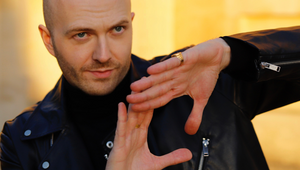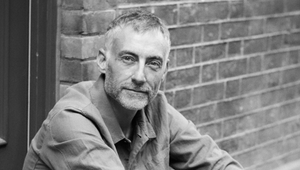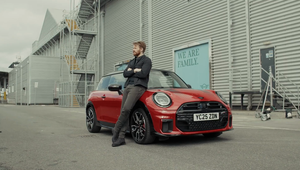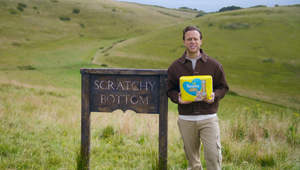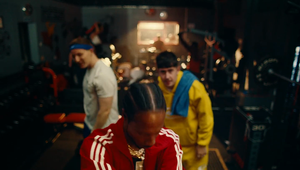
Morten Vinther on Human Storytelling in a Digital Era

For certain generations, some of the stories we remember most profoundly include those in video games. Be they the more traditional narratives of ‘Uncharted’ or ‘The Last of Us’, to the tales we tell ourselves in more open-ended classics like ‘Skyrim’ and ‘The Legend of Zelda’, interactive mediums have become a huge part of our cultural world.
Morten Vinther is a director, creative director, and VFX supervisor who gets that instinctively. He’s directed beautiful ads for the likes of Dell and Alienware, alongside cinematics and trailers for AAA blockbuster video games like ‘The Last of Us: Part II’ and ‘Star Wars Jedi: Survivor’. That experience has given him a unique perspective on storytelling in the digital age - weaving traditional influences into modern sensibilities.
With Morten having recently joined the team at Great Guns, now felt like the perfect time to sit down with the director and pick through the themes of his career so far. Along the way, we touched on the influence of French and Danish cinema, the rise of AI, and how to stop processes getting in the way of an ‘authentic performance’…
LBB> Morten, let’s start at the beginning - what kind of a kid were you growing up, and at what point did you first start to think of yourself as a creative person?
Morten> I grew up in a small town in Denmark. I spent my time after school either playing computer games or outside, creating imaginary worlds with my friends. Later, I played in bands, dreaming of one day becoming a rock star. That sadly hasn't happened yet, but at one point I discovered cameras and how you could create emotions by editing footage and music together. I think that’s when I got hooked, and wanted to pursue something along these lines.
LBB> What are the earliest creative influences that you can remember?
Morten> Oh boy, there are so many! In terms of films, I remember watching Luc Besson’s ‘Le Dernier Combat’ as a teenager and being incredibly fascinated by it. It’s a black and white film featuring a young Jean Reno in a post-apocalyptic world, where people have lost their ability to speak. I was amazed that you could hold tension and create an exciting film almost entirely without using any dialogue.
Similarly, I was impressed by the wave of Danish cinema called ‘Dogma’. It followed strict rules to create films based upon traditional values. These films excluded the use of visual effects, for example - the idea was to focus entirely on substance over style. Ironically, I later became an accomplished visual effects artist!
LBB> Your work on ‘The Last of Us: Part II’ has rightly won you awards and acclaim. When you’re working on game cinematics, what’s the key to making them feel grounded and real in the context of their own worlds?
Morten> Understanding the characters, their motivations, desires and their world is crucial in making them feel believable. There’s so much research that goes into it. I always want to make the characters feel authentic, so I tend to gravitate towards creating characters that have to work for their success. It’s always more interesting to watch someone do something that feels hard-earned and difficult. Life can be a struggle sometimes - even within game cinematics.
With the launch film for ‘The Last of Us: Part II’, the key was to cast actors who could deliver a believable performance. As the main character doesn’t exist in real life, it brought on some additional complications in that I needed to cast an actor who had a particular facial structure for the tech to work - while also being able to deliver a great emotional performance. It wasn’t easy, but we got there in the end.
LBB> Are there any other recent projects which stand out in your memory as especially significant?
Morten> ‘Arena Breakout: Winner Takes All’. I love this little film as a piece of drama. It’s gritty, dark and beautifully reflects the nature of the game itself. The film is for a genre of gaming that I enjoy playing. The camera work and the haunting score are spot-on, and the visuals have an eerie realism to them. A few of the cast were ex-marine corps members and I had a navy seal specialist with me on set the whole time to make sure that we stayed 100% authentic to real life in terms of weapons handling and choreography, down to how you would secure a tourniquet. The concept of following the weapon changing hands, rather than a single character throughout is interesting.
LBB> Do you think that gaming is becoming more cinematic in its visuals generally, or is it becoming something else entirely?
Morten> Interesting question! I think the focus for most studios is to create an immersive experience for the player. Sometimes, we are influenced by cinema to help create that feeling, but gaming goes well beyond the traditional rules that we associate with cinema. Although there is crossover, it’s a different format and experience.
It's exciting that visuals in gaming keeps getting better and better in terms of the craft and aesthetics applied. Cinematography and lighting in particular has improved so much. For me, it's been interesting to watch how gaming is influencing cinema and TV more and more, so it definitely works both ways.
LBB> You’ve talked previously about your love for storytelling. How would you describe the difference between storytelling in an interactive medium like gaming, and a more traditional linear medium like TV or cinema?
Morten> I’m working on a project right now where the audience decides where the story takes them. Their input literally decides what happens next and they become part of the story. This kind of participation engages people in a completely different way to traditional TV and cinema, but to be honest, it doesn’t always make for a better story. The audience participation can actually sabotage the narrative, but I love the fact that they can go back and get a completely different experience the next time. With TV and cinema, you get to impose your clear vision and steer the audience exactly where you want to take them. It’s a more finely curated experience.
LBB> What’s the key to getting the best, most emotional performance out of an actor?
Morten> I always strive to get real human emotions out of the characters in my films. Trust, understanding, and a lot of listening are key to achieving that goal. I’m a firm believer in giving people space and ownership to develop the characters. Collaboration is key for me.
LBB> And how does that change when you’re working with CG?
Morten> I don’t like when something ‘feels’ like it’s made in CG, so my process is really similar to traditional live action in that it begins with finding great actors. I spend a lot of time at the start of a project casting the right actors for the roles. I do callbacks and walk through the scripts with the cast. My favourite part is when we do a table read and get everybody familiar with the characters. This is when that script finally begins to come alive and people are riffing off each other. It’s magic. I still go through the process of selecting wardrobe, hair styles, art dept, props, etc. If there are stunts involved on the project, I do rehearsals and stunt-visualisation with my stunt coordinator in the days leading up to the shoot.
The actual shoot happens on mocap stages with the actors wearing suits and head mounted cameras - similar to what you may have seen in behind-the-scenes footage from films like Avatar. I always shoot virtual cameras of the performances on the day to make the scenes feel authentic. Throughout, I work very closely with my DP to consider lighting, lensing, movement, colour, and composition. We also scout virtually in most cases, which is really helpful.
All in all, it’s actually a very similar process to shooting traditional live action, but I think it’s way harder. It's more complicated and takes longer, because there are so many steps to go through and technology involved - it takes an army of people to make these. It’s more difficult for the actors too, as there can be many distractions on set. If you’re not careful, the process can get in the way of an authentic performance.
LBB> Finally, we’re having this conversation at a time when it feels like the industry’s favourite buzzword is ‘AI’. Have you used the technology much in your own work, and does it leave you feeling more excited or more fearful about the industry’s future?
Morten> The world of visual effects has been using machine learning for quite some time. It’s been really great at speeding up certain tasks which perhaps weren’t so exciting to do in the first place. It’s also enabled us to do things that we simply couldn’t do before. There are fun, trippy or haunting visual ideas that seem to accidentally happen when you’re messing with AI. I’m excited about any tool that can help ease the burden of repetitive, non-creative work and give us more time to focus on the creative.
I love this industry because it is always changing and we’re not afraid of trying new things. Will AI replace everything that we do? And can AI connect with us on a deeper emotional level? I don’t think so. At the end of the day we’re humans and I can’t think of better beings to create authentic human stories.










